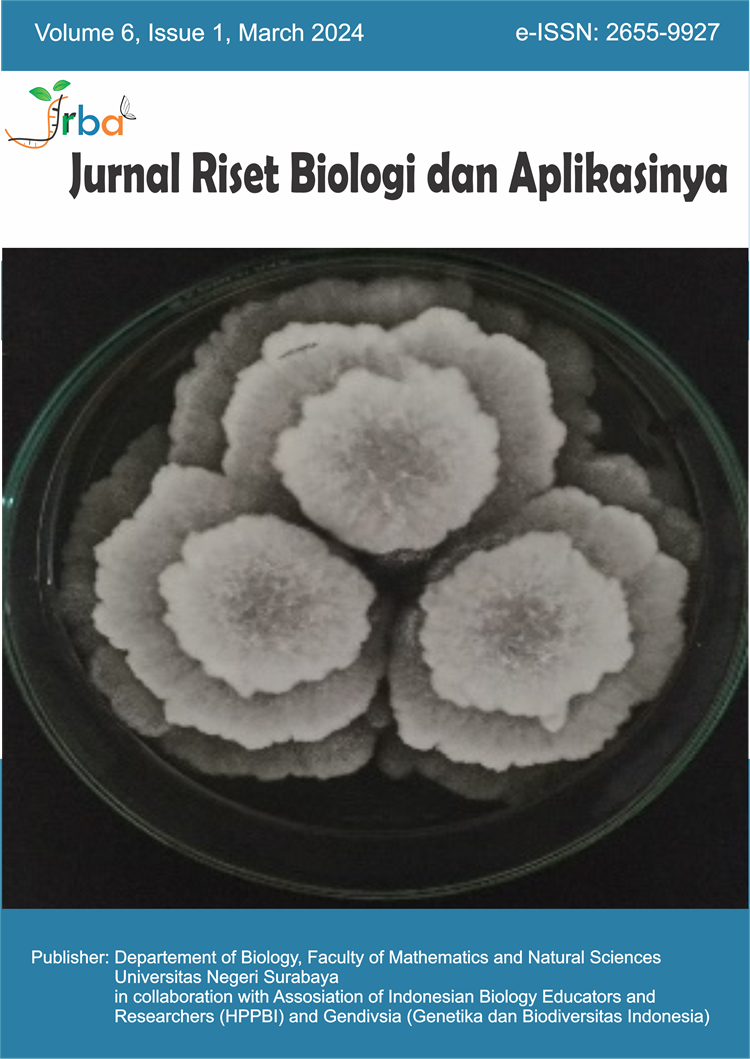In Vitro Evaluation of Phosphate-Solubilizing Bacteria as Antagonists for Bacterial Leaf Blight Disease (Xanthomonas oryzae pv. oryzae)
DOI:
https://doi.org/10.26740/jrba.v6n1.p34-40Abstract
Rice is an important food crop in Indonesia, where more than 50% of the Indonesian population consumes rice as a staple food. Rice has decreased productivity by 50-80% due to bacterial leaf blight caused by Xanthomonas oryzae pv. oryzae (Xoo). The rapid spread and damaging effects of pesticide use on the environment are the main obstacles in the treatment of these bacteria. Alternative control is to use biological agents in the form of phosphate solubilizing bacteria (PSB). Phosphate-solubilizing bacteria are part of the growth-promoting bacteria that have other abilities, namely biocontrol. The purpose of this study was to develop the ability of acid soil phosphate solubilizing bacteria to inhibit growth in vitro. The test was carried out using the dual culture technique with the zone of inhibition method. The results showed that ten isolates of PSB had inhibition against Xoo with various diameters of inhibition. The four highest inhibitory isolates were EF.NAP 3 (5.267 ± 0.189 mm), Pseudomonas GSP 6 (4533 ± 0.772 mm), EF.NAP 4 (3,424 ± 0.161 mm) and EF. NAP 9 (3.167±0.136 mm). The ability of PSB to inhibit Xoo can be used as an alternative in controlling bacterial leaf blight in rice plants. This indicates that the PSB isolate acts as a biostimulant in the dissolution of phosphate in the soil and as a bioprotectant.
References
Bardin, M., Ajouz, S., Comby, M., Lopez-Ferber, M., Graillot, B., Siegwart, M., & Nicot, P. C. (2015). Is the efficacy of biological control against plant diseases likely to be more durable than that of chemical pesticides? Frontiers in Plant Science, 6(JULY). https://doi.org/10.3389/FPLS.2015.00566
Blok, W. J., Lamers, J. G., Termorshuizen, A. J., & Bollen, G. J. (2007). Control of soilborne plant pathogens by incorporating fresh organic amendments followed by tarping. https://doi.org/10.1094/PHYTO.2000.90.3.253
BPS. (2018). Luas panen dan produksi beras di indonesia (harvasted area and rice production in Indonesia). In Badan Pusat Statistik. Badan Pusat Statistika Indonesia. https://www.bps.go.id/publication/2018/12/21/7faa198f77150c12c31df395/ringkasan-eksekutif-luas-panen-dan-produksi-beras-di-indonesia-2018.html
BPS. (2021). Produksi, luas panen dan produktivitas padi di Indonesia. https://www.bps.go.id/indicator/53/1498/1/luas-panen-produksi-dan-produktivitas-padi-menurut-provinsi.html
Direktorat Perlindungan Tanaman Pangan. (2012). Laporan tahunan direktorat perlindungan tanaman pangan tahun 2012.
Jin, P., Wang, Y., Tan, Z., Liu, W., & Miao, W. (2020). Antibacterial activity and rice-induced resistance, mediated by C15surfactin A, in controlling rice disease caused by Xanthomonas oryzae pv. oryzae. Pesticide Biochemistry and Physiology, 169, 104669. https://doi.org/10.1016/J.PESTBP.2020.104669
Mew, T. W., Alvarez, A. M., Leach, J. E., & Swings, J. (1993). Focus on bacterial blight of rice. Plant Disease, 77(1), 12. https://doi.org/10.1094/PD-77-0005
Ouchari, L., Boukeskasse, A., Bouizgarne, B., & Ouhdouch, Y. (2019). Antimicrobial potential of actinomycetes isolated from the unexplored hot Merzouga desert and their taxonomic diversity. Biology Open, 8(2). https://doi.org/10.1242/BIO.035410
Rasul, M., Yasmin, S., Zubair, M., Mahreen, N., Yousaf, S., Arif, M., Sajid, Z. I., & Mirza, M. S. (2019). Phosphate solubilizers as antagonists for bacterial leaf blight with improved rice growth in phosphorus deficit soil. Biological Control, 136, 103997. https://doi.org/10.1016/J.BIOCONTROL.2019.05.016
Suleman, M., Yasmin, S., Rasul, M., Yahya, M., Atta, B. M., & Mirza, M. S. (2018). Phosphate solubilizing bacteria with glucose dehydrogenase gene for phosphorus uptake and beneficial effects on wheat. PLOS ONE, 13(9), e0204408. https://doi.org/10.1371/JOURNAL.PONE.0204408
Yasmin, S., Zaka, A., Imran, A., Zahid, M. A., Yousaf, S., Rasul, G., Arif, M., & Mirza, M. S. (2016). Plant growth promotion and suppression of bacterial leaf blight in rice by inoculated bacteria. PLOS ONE, 11(8), e0160688. https://doi.org/10.1371/JOURNAL.PONE.0160688
Downloads
Published
How to Cite
Issue
Section
License
Copyright (c) 2024 Jurnal Riset Biologi dan Aplikasinya

This work is licensed under a Creative Commons Attribution-NonCommercial 4.0 International License.
 Abstract views: 305
,
Abstract views: 305
, PDF Downloads: 357
PDF Downloads: 357












